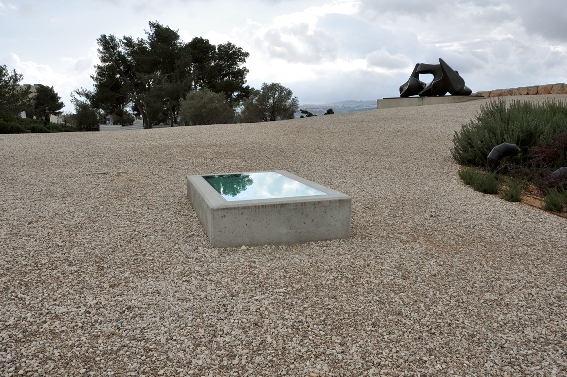
Micha Ullman’s major retrospective The Sands of Time opens at the Israel Museum on Tuesday, June 21st, the date of the Summer Solstice, celebrated by the Druids as the “wedding of Heaven and Earth”. This seems appropriate, given the fact that cosmic elements are integral to many of the sculptures and drawings in this exhibition, including Equinox, Ullman’s glass and concrete installation on permanent display in the Museum’s garden that explores the sun’s play of light and shadow on an underground cell.
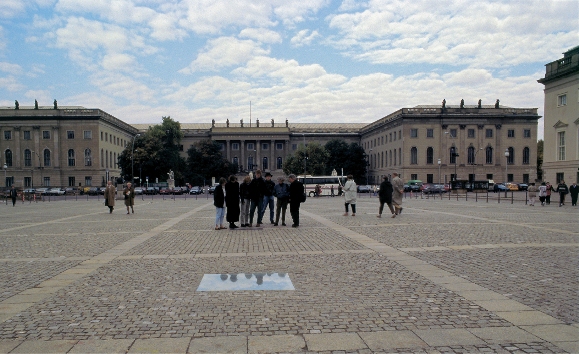
On view in the documentation area of this show (a section not to be missed), is a film showing the construction of the Library, a sister work to Equinox. This, Ullman’s best known, site-specific piece, is located at Bebelplatz, Berlin, where on May 10, 1933, some 20,000 books authored by Jews, communists and pacifists were burnt by staff and students of Humboldt University.
This installation is in the form of a subterranean void sealed off with glass. It contains only empty shelves calculated to hold the approximate number of books destroyed. The interior of this room is rarely seen clearly from the plaza; changing light and weather conditions, shadows and reflections of buildings and people continually altering one’s perception. A plaque at street level bears the prophetic words of Heinrich Heine: “Where books are burned, in the end people will burn.”
Nevertheless, Ullman has stated that the aim of this work was “not to accuse anyone; but bring people together to talk, questions and think.” And, to judge by the groups of people forming and reforming around this site, as witnessed a month ago, this aim is being achieved.
Among the many remarkable sets of drawings on view in this show is the highly evocative series that ‘grew’ out of the Library project. In it, graphite powder scattered over sheets of paper coalesces to form soft, ephemeral shapes that evoke, like the Berlin monument, images of ground and sky, smoke and clouds, as well as thoughts of life and death.
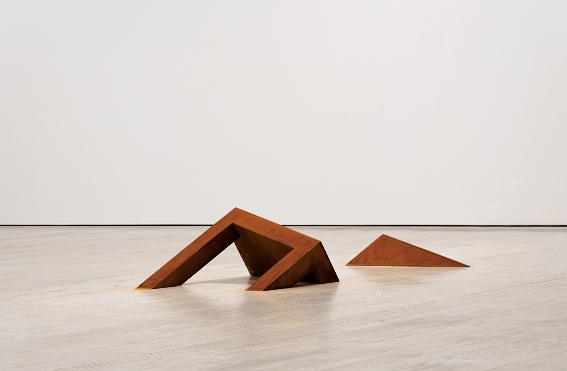
The 40 three-dimensional works on display, representing half-a-century’s intensive work, comprise minimalistic-geometric objects constructed from dissonant materials: rusted iron plates, cold and hard; red sand, soft and loose. Their juxtaposition is a metaphor, perhaps, for the tensions existing between the concrete-real world and the spiritual-intangible; or else between the very different peoples inhabiting this Land.
Sited in one large space, these large and small works form a single, very forceful work of art. First come two man-size constructions that are archetypal images of a house, a central theme in Ullman’s work: the ‘stable’ Midnight followed by Day, an upside down house, both from his 1988 Containers series. The other sculptures, sited in decreasing order of size, represent a building in various stages of collapse, with the final fragments of tables, walls and chairs splayed across the floor or half-buried in it. The overall effect is of a city rising from the ground or sinking into it, a scenario that is topical if one thinks of recent ecological disasters.
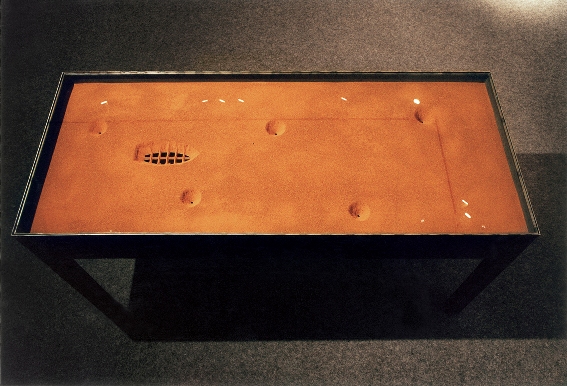
Located in the Documents section is Place (1975), one of the earliest videos produced in Israel. It is of special interest since it records Ullman’s early fascination with sand. Then a young lecturer at Bezalel, he is depicted sweeping it up into mounds or flattening it into depressions. Some 20 years later, this gestural activity resurfaced in the making of the Sand Tables that are such a prominent feature of this exhibition. Here, holes and paths burrowed into the smooth top layers of sand (some of which has escaped through holes bored in containers) form the negative shapes of fish or eating utensils.
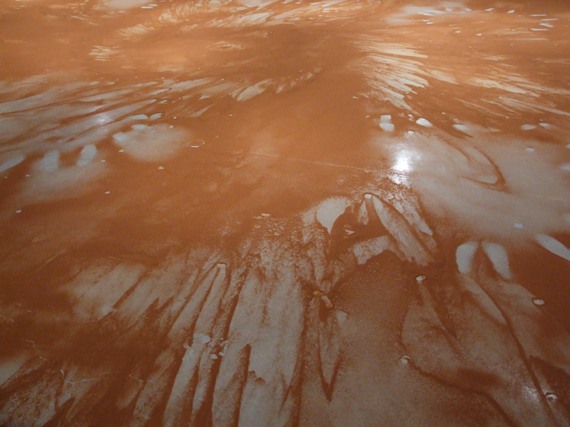
Wedding, an installation employing Ullman’s unique sand-throwing technique, was created only a week before the opening. 100 volunteers were invited to be guests at the mock wedding that took place in a huge gallery space. When they were settled at their tables Ullman threw clouds of red sand across the room. After the ceremony, all the furniture was removed and the guests asked to leave, while minimally disturbing the new floor covering. Yet, this empty room still bears evidence of this event. Aside from footprints, there are memory traces of the wedding ceremony: shards of the glass traditionally stamped on at Jewish weddings to remember the destruction of Temple. The overall impression now is of a huge ‘action’ painting. But, like so many of Ullman’s works, this streaked red abstraction has ambiguous connotations. If one hadn’t been aware of the performance that resulted in its creation, then it would have been possible to imagine that something terrible had happened here.
Ullman’s most recent piece, completed a week before the opening of this exhibition, comprises a single grain of sand ‘captured’ and illuminated under glass. It recalls lines from a poem by William Blake that resonate with Ullman’s art: “To see a world in a grain of sand….is to hold infinity in the palm of your hands, and eternity in an hour.”
Israel Museum, Jerusalem. Till November 12, 2011.






How intriguing the comments on such a wonderful artist. This is a project by Micha Ullman incorporating sculptural research into an urban scheme by AA trained architect H.R.Hiegel: http://short.hiegel.de/ullman_09
Comments are closed.